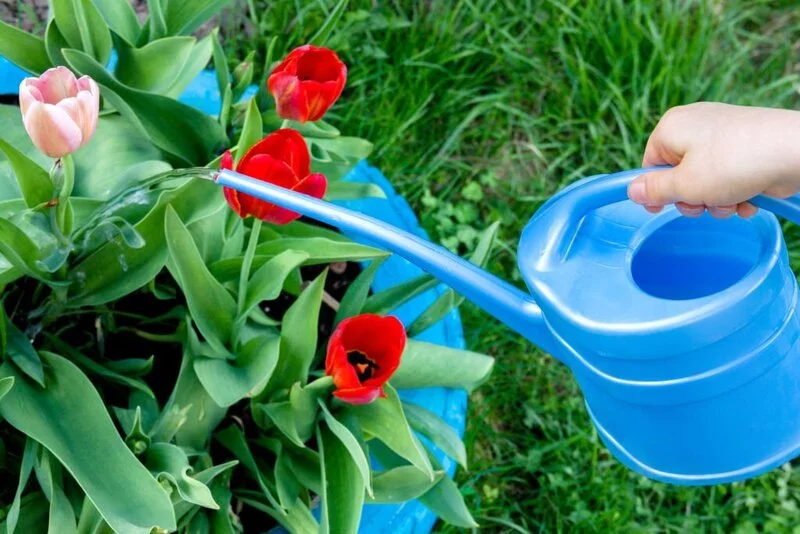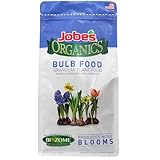The sight of bright and cheery tulips is a sure sign that spring has sprung. These beautiful flowers can bring a burst of color and life to any garden. But as any tulip lover knows, keeping these stunning blooms at their best involves understanding their specific watering needs. So, if you’re wondering, “How often should I water my tulips?” then you’ve come to the right place. This guide will lead you through the ins and outs of quenching your tulips’ thirst.
- Organic granular fertilizer; Fast acting bulb fertilizer for tulips, daffodils, lilies and other bulb flowers
- OMRI listed for organic gardening by USDA; Certified organic means no synthetic chemicals
- Contains Jobe’s Biozome.the proprietary microorganism archaea that aggressively breaks down material for faster results
- Jobe’s Biozome improves soil conditions, helps and drought during the growing season
- Easy pour bag; Guaranteed fertilizer analysis: (3-5-4) 4 pound bag; Apply every 3 to 5 weeks
Tulip Water Needs
Just like us, plants need water to stay healthy. But the amount and frequency of watering can make a big difference in a plant’s health and growth. So, what about tulips? How much do these springtime stunners really need?
Tulips are quite resilient and can handle a range of conditions. However, they do prefer well-drained soil that’s kept consistently moist, but not soggy. You might think, “So I should water them all the time?” Well, not quite!
During their growth and blooming period in the spring, tulips appreciate a drink once a week, provided that the weather isn’t too hot or too dry. A good rule of thumb is to water them deeply so that the moisture reaches their roots, then allow the top inch of soil to dry out before watering again. This helps prevent overwatering and ensures the tulips’ roots are well-hydrated.
It’s important to note, though, that this is a general guide. Several factors can influence your tulips’ watering needs, which we’ll explore in the next section. Ready to become a tulip watering master? Let’s dive in!
Factors Influencing Watering Frequency
While the once-a-week rule is a good starting point, you should always consider the specific conditions in your garden. Let’s talk about some factors that can change how often your tulips need water:
- Weather: If it’s hot and dry, your tulips might need more frequent watering. On the other hand, if it’s cool and rainy, nature may be doing the watering for you.
- Soil Type: Different soils have different drainage abilities. If your soil is sandy, it drains faster, and your tulips may need watering more often. But if your soil is heavy clay, it retains water longer, so you might need to water less frequently.
- Stage of Growth: Tulips need more water when they’re actively growing and blooming. But when they’re dormant—after blooming and before the next growth cycle—they need much less.
Remember, the goal is to keep the soil consistently moist but not waterlogged. Keeping an eye on these factors will help you do just that.
Signs of Overwatering and Underwatering
Now that we know what influences watering frequency, let’s discuss what can happen if we get it wrong. Like Goldilocks, tulips don’t want too much or too little water—they want it just right.
Overwatering Signs: If your tulips are getting too much water, you might notice yellowing leaves, drooping or wilting, and even bulb rot. If you dig up a bulb and it’s mushy or smells bad, overwatering could be the culprit.
Underwatering Signs: On the flip side, if your tulips aren’t getting enough water, they may have brown, crispy leaf edges, stunted growth, and reduced blooming. The bulbs might also be shriveled or dry when dug up.
Being able to recognize these signs can help you adjust your watering habits and keep your tulips happy. After all, happy tulips mean a happy garden!
Best Practices for Watering Tulips
Now that you’re a pro at spotting signs of overwatering and underwatering, let’s look at the best practices for watering your tulips:
- Water Deeply: Instead of giving your tulips a light sprinkle every day, opt for a good soak once a week. This encourages the roots to grow deeper into the soil, making for stronger, healthier plants.
- Water in the Morning: Watering early in the day allows the moisture to soak in before the heat of the day evaporates it. Plus, it helps prevent diseases that can develop from water sitting on the leaves overnight.
- Mind the Weather: If it’s been dry and hot, your tulips might need an extra drink. If it’s been raining, you can skip a watering day. Always check the soil first before watering.
- Use Mulch: Mulch not only makes your garden look tidy, but it also helps to keep the soil moist. A layer of mulch around your tulips can reduce the need for frequent watering.
- ALL-NATURAL INGREDIENTS: No added fertilizers or pesticides
- USES: Potted plant decor, landscaping, terrariums, or soil supplement, soil barrier, bonsai care
- BENEFITS: Drainage, enhances appearance, water retention, blocks pesky creatures
- INGREDIENTS: 100% pine bark mulch, average size 1/2-inch pieces
- SIZE: 8 quarts (enough for a big 12-inch pot)
Conclusion
Tulips are a joy to grow, and knowing how to water them correctly makes the process even more rewarding. Remember, every garden is unique, so pay attention to your plants and adjust their watering schedule as needed. The result will be happy, healthy tulips that fill your garden with vibrant colors and grace. Now, armed with your watering know-how, you’re ready to give your tulips the care they deserve.






